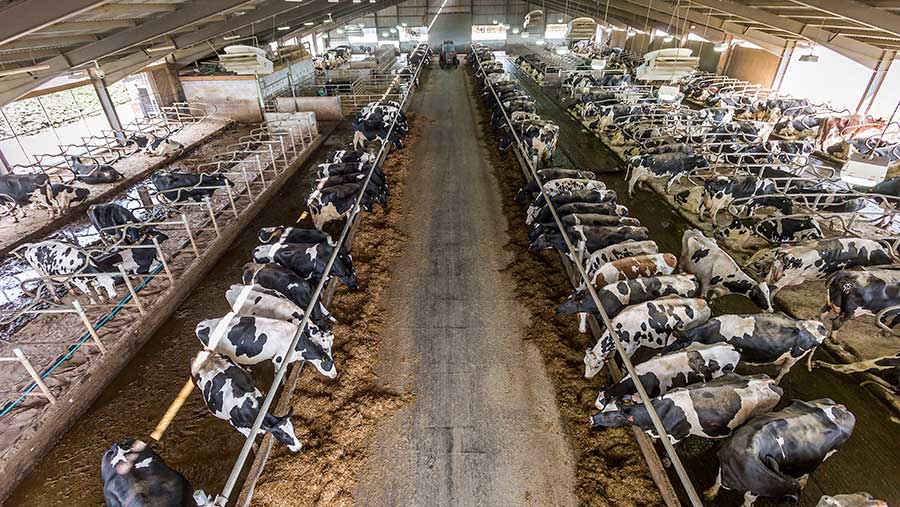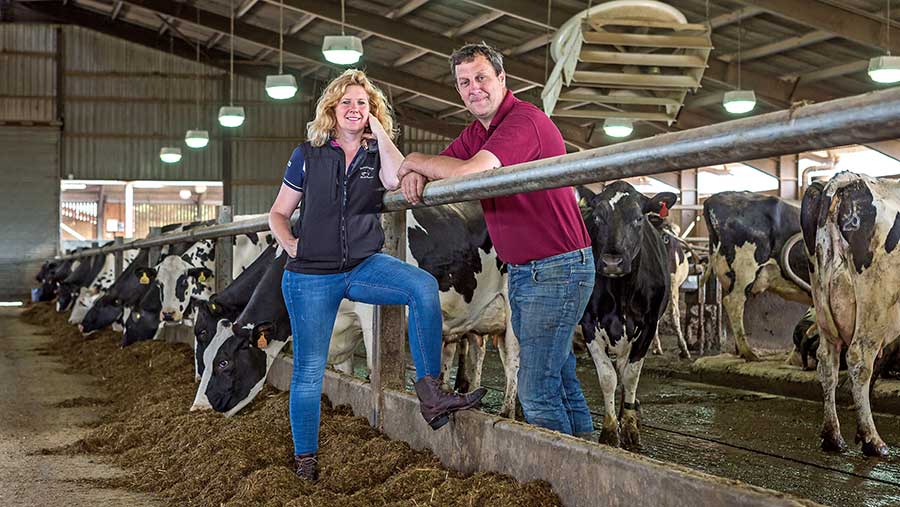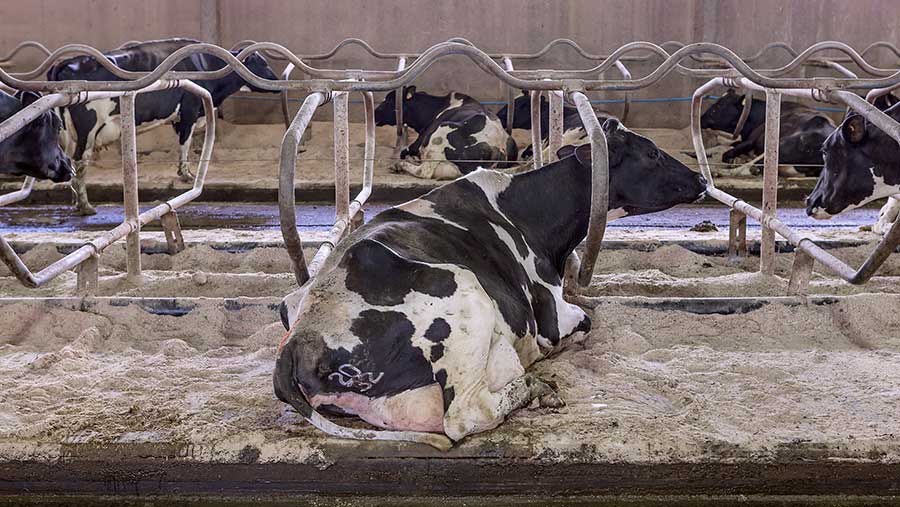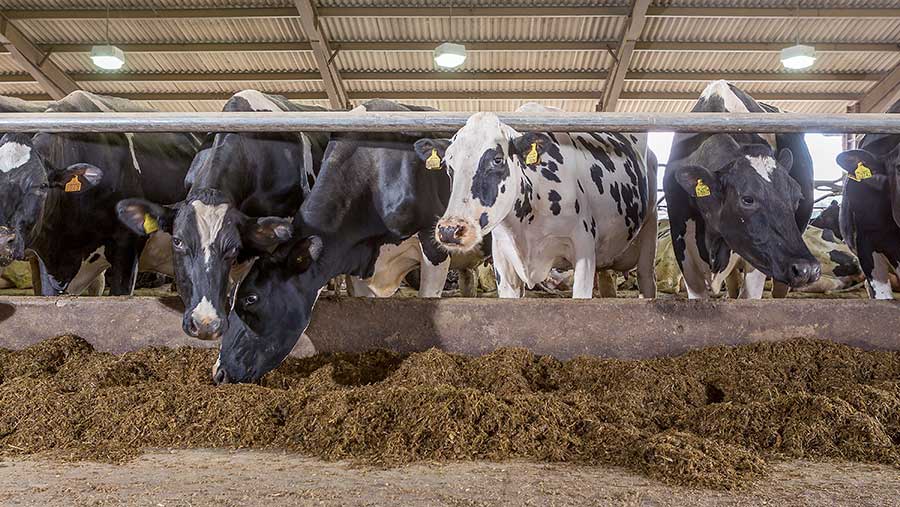4 steps to increase dry cow shed efficiency
An investment in improving dry cow accommodation is time and money well spent.
Not only does every cow on the farm pass through this shed, but it sets a cow up for subsequent lactation, according to independent consultant Hefin Richards of Profeed Nutrition Consultancy.
Mr Richards says assessing cow behaviour can give you a good indication of where the bottlenecks are in your dry cow housing and systems.
Read the other parts of our livestock housing special
He says that every dairy producer should ask: “Are cows comfortable? Are they happy to eat at any point of the feed rail? Are they happy to lie down at any point in the shed?”

© Richard Stanton
What to look for in dry cow sheds
1. Adequate lying space
What to look out for
- Cows not lying for at least 12 hours
- Cows lying half in or half out of cubicles suggests adjustments are required
- Overcrowding and cows not able to comfortably lie down
- Space can be a big limiting factor in dry cow sheds, yet farmers often commit the cardinal sin of overstocking them. This can badly affect cows’ behaviour.
- In bedded straw yards, lying space should be a minimum 1sq m/1,000 litres of target milk yield for transition cows.
- In cubicle sheds the target should be a stocking rate of 80-90% – remember these cows are at their biggest physical size in their lactation cycle.
- Always factor in more space then you need or have a plan B to ensure transition housing is not overstocked.
- To achieve this, work out your average calving rate and work to 130-140% of that. For example, if you have 10 cows calving every week on average and you want them in your close-up/transition housing for three weeks; that is 30 cows on average. Multiply this by 130-140% and ensure you have enough space for 39-42 cows. Otherwise, this area will be overstocked 50% of the time, affecting 50% of your herd.
2. Provision of fresh and clean water
What to look out for
- Animals not observed drinking or dehydrated animals
Freshly calved cows drink up to 20 litres or more of water after calving, so ensuring water is clean and plentiful is key.
- Provide 10cm a cow of linear trough space (eight cows = 80cm).
- Flow rate should be at least 10 litres/minute.
- Keep it clean. Use troughs that are easy to clean, such as tippable ones or troughs with drain holes, and check them daily for contamination and clean when necessary.
- Place water troughs in areas of easy access such as crossovers and avoid dead ends.
3. Correct space at the trough and access to fresh feed
What to look out for
- Fall in group dry matter intakes
- Too much feed left over
- Rubbed necks
- Cows being bullied away from the trough or not enough room for all to feed at once
Farmers should target a minimum dry matter intake of 13kg an animal in close-up dry cows. To achieve this:
- Allow 0.9m of feed space a cow to avoid bullying at the feed fence if you have a feed rail.
- Where you have self-locking yokes, stock them at 80-85%. Ideally cows should be introduced to yokes during the heifer-rearing stage to avoid stress and poor intakes pre-calving.
- Make sure feed is consistent, well presented, palatable and fresh.
- Use resin or plastic-coated floors at the feed fence to encourage feed intakes and to facilitate the easy removal of rejected feed.
- Neck rails should be smooth and positioned at the correct height. If cows are rubbing their necks it can be uncomfortable, which will limit feeding time.
4. Avoid heat stress
What to look out for
- Cows refusing to lie down or eat in certain parts of the shed where airflow is poor
- Signs of heat stress such as increased breathing, panting or fall in intakes
Close-up calving and fresh cows are incredibly susceptible to heat stress and it is a huge risk for reduced feed intake. Yet dry cows are often kept in poorly ventilated sheds because of space issues and they become second-rate to milkers.
If air flow is poor, straw yards can become a breeding ground for bacteria.
- Open up roof ridges (0.2-0.3m-wide minimum) and side inlets (twice the size of inlet areas)
- Where air flow is limited, install fans to provide air exchange and cow cooling.
See also: Six ways dairy farmers can increase milk hygiene levels
Farm case study

Sarah and John Allwood at Huntington Hall Farm © Richard Stanton
At Huntington Hall Farm, Nantwich, Cheshire, state-of-the-art dry cow facilities are aiding exceptional fertility, with a pregnancy rate of 30%.
This has helped boost production in the 700-head Holstein herd to 11,405 litres sold with yields projected to lift to over 12,000 litres a cow by March 2018.
Farmers John and Sarah Allwood erected a new dry cow shed three years ago to replace an existing straw-bedded yard and calving boxes. At the time cows would rejoin the milking herd post calving. But the new shed has made transition management much smoother and enabled a separate fresh-cow group to be run.
Dry cow management changes
Dry cows are moved into a two-row “close-up pen” of cubicles three weeks prior to calving and stay in the same shed until they are two weeks freshly calved, on average.
Cows are currently fed a twice daily – to avoid TMR overheating – via a railed feed fence.
One diet is fed throughout the 60-day dry period to minimise change for the cows, with cows receiving 7kg a head of chopped wheat straw, alongside Trafford syrup, water, silage and maize, plus minerals and 0.5kg soya. Wheat straw currently makes up 48% of the diet.

Huntington Hall Farm © Richard Stanton
The Allwoods operate a “just-in-time” calving policy to reduce stress. Cows get moved at calving from the cubicles into one of three adjoining straw-bedded calving pens.
From here they move across into a fresh cow group of 28-sand bedded cubicles where they can be milked separately through the parlour and monitored closely for the first 10-20 days.
Key features of the shed
- Tippable troughs that can be cleaned out regularly
- Variable fans fitted over the beds to improve airflow
- Automatic side curtains
Mr Richards says having cows that stay in the same environment during transition reduces stress.
He adds: “There’s nothing worse than the idea of a segregated calving box where cows are moved into a completely new environment away from their herd mates.
“A cow needs to give birth in a comfortable, safe, stress-free environment. If it’s not it will slow the process down.”

Huntington Hall Farm © Richard Stanton
Multi-cut system silage
As well as improving the environment, the Allwoods have now also switched to a multi-cut system silage to improve the quality of their forage.
Silages are cut using a reciprocating knife block cutter, and the mixer wagon is fitted with programmable weighing technology which has improved consistency and accuracy of feeding, according to Mr Richards.
The Allwoods are also using a pre-synchronisation programme to ensure that all cows have been served within 70 days of calving.
Mr Allwood credits all of these changes with increasing 21-day pregnancy rates by 5%, with conception rates currently hitting 42%.
“The proof is in the higher pregnancy rates. It’s a combination of things but transition is a big part of it,” says Mr Allwood.
Fertility
- 100-day in calf rate 64%
- 21-day pregnancy rate -30%
- Conception rate 42%
- Services per pregnancy 2.4%
Farm facts: Huntington Hall Farm, Nantwich
- Milking 700 cows
- Supplying Tesco Muller
- 80ha owned with a further 207ha and 62ha of maize contract grown
- Average age at first calving is currently 23.1 months
- Using Genus RMS to carry out fertility work on cows and replacement heifers
- Averaging 11,405 litres sold a cow (averaging 36.7 litres a cow a day)
- Two milking cow rations, single dry cow and rearing heifer TMR.
- Cows milked three times daily – no in-parlour feeding
